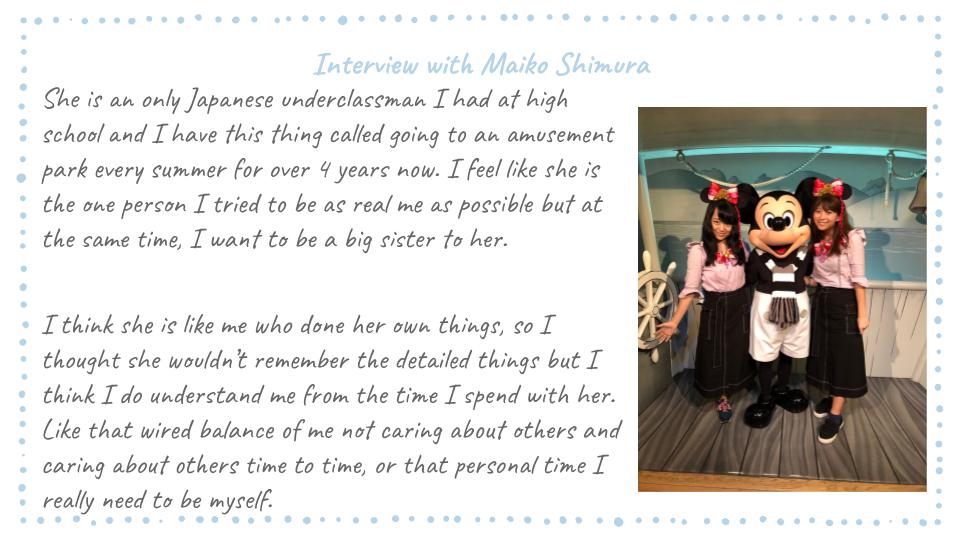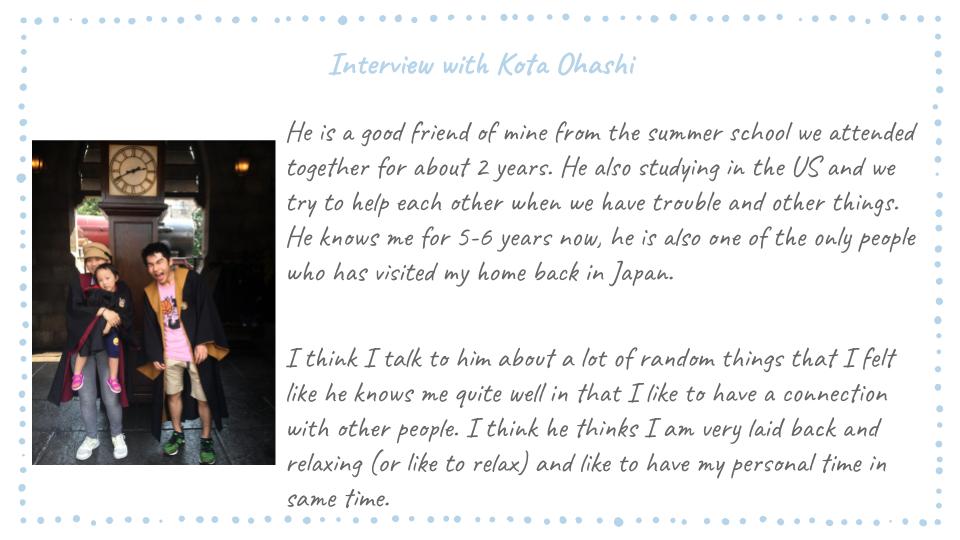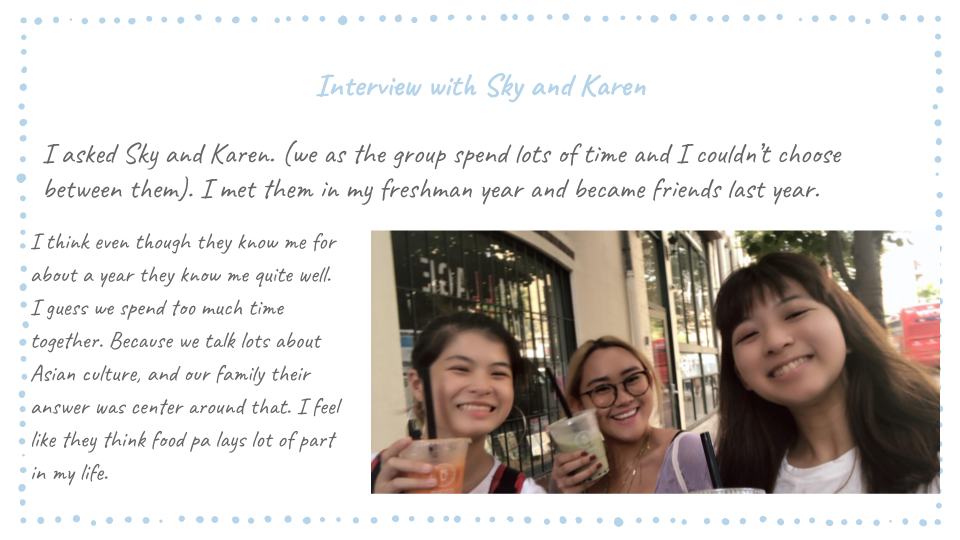

Mapping the Self is the first project done in the Core Studio System that we seek better understanding of ourselves through research, interviewing ourselves from outside and come up with three studies:

So because I wasn’t sure about what I wanted to dive in, I just started with re-visiting some of the reading that influenced me in the way then I started to type in the words that I am interested to keep learning in my life. Most of them are either about gender equality and LGBT issues in Japan or about the digital media. I guess those two sounds totally separate thing about as I read the articles I realized that maybe gender equality and LGBT issues in Japan is not as solved as the USA or not really focused from the other countries but it’s been always addressed in some of the sub-culture in Japan. So I went in to see some article about women’s power in Japanese anime and comic and how Japanese artist sees the women power a little bit different from other countries. One of the citations I made is an article I needed to read in my first year about how Japanese cute culture doesn’t support feminism. And I do strongly disagree with that article. The author is an Asian woman who grew up in the USA, not in Japan. As a woman who grew up in Japan and has been immersed in does culture, I had a totally opposite idea on feminism in Japanese sub-culture. I grew up getting the hope of being smart, strong, being vocal women while being cute. I guess the idea of cute is difficult to communicate but I was just so shocked to see in different culture people could see the same media and get a totally different idea. Many of the reading I did for this assignment is about Japanese culture that is going on right now in Japan. As a Japanese, I am always interested to see how other culture sees a specific unique culture in Japan. And I think it’s something I need to explore as a Japanese.
Lai, Adrienne. “Towards a Critical Understanding of “Asian Cute Culture”,” in Youth Subculture.Didion, Joan. “Goodbye to All That,” in Slouching towards Bethlehem. 4th Estate, 2017.
Mclelland, Mark. “Japan’s Queer Cultures.” Routledge Handbook of Japanese Culture and Society, doi:10.4324/9780203818459.ch11.
Ippolito, Jean M. “Words, Images and Avatars: Explorations of Physical Place and Virtual Space by Japanese Electronic Media Artists.” Leonardo, vol. 42, no. 5, 2009, pp. 421–395. JSTOR, JSTOR, www.jstor.org/stable/40540060.
VAN SAAZE, VIVIAN. “From Intention to Interaction: Artist’s Intention Reconsidered.” Installation Art and the Museum: Presentation and Conservation of Changing Artworks, Amsterdam University Press, 2013, pp. 109–142. JSTOR, www.jstor.org/stable/j.ctt46n18r.7.
Robins, Robert S., and Len Oakes. “Prophetic Charisma: The Psychology of Revolutionary Religious Personalities.” Nova Religio: The Journal of Alternative and Emergent Religions, vol. 2, no. 2, 1999, pp. 321–322. JSTOR, JSTOR, www.jstor.org/stable/10.1525/nr.1999.2.2.321.
Popova, Maria. “Nietzsche on How to Find Yourself and the True Value of Education.” Brain Pickings, 22 June 2016, www.brainpickings.org/2015/09/30/nietzsche-find-yourself-schopenhauer-as-educator/.
“Relationships Among People | TeamLab / チームラボ.” Story of the Forest | TeamLab / チームラボ, www.teamlab.art/concept/Relationships/.
Kozhevnikov, Michael, et al. “Learning Relative Motion Concepts in Immersive and Non-Immersive Virtual Environments.” Journal of Science Education and Technology, vol. 22, no. 6, 2013, pp. 952–962. JSTOR, JSTOR, www.jstor.org/stable/24019769.
Richard, Moniques. “Body Machine: Exploring Technological Fictions through a Collaborative Artistic Event in Schools.” Visual Arts Research, vol. 31, no. 1, 2005, pp. 38–52. JSTOR, JSTOR, www.jstor.org/stable/20715367.
DeRoo, Neal. “Transcending Boundaries in Philosophy and Theology: Richard Kearney’s (Double) Vision.” Revista Portuguesa De Filosofia, vol. 65, 2009, pp. 1319–1327. JSTOR, JSTOR, www.jstor.org/stable/41220935.
Huws, Ursula. “Nature, Technology and Art: The Emergence of a New Relationship?” Leonardo, vol. 33, no. 1, 2000, pp. 33–40. JSTOR, JSTOR, www.jstor.org/stable/1576759.
SAITO, KUMIKO. “Magic, ‘Shōjo’, and Metamorphosis: Magical Girl Anime and the Challenges of Changing Gender Identities in Japanese Society.” The Journal of Asian Studies, vol. 73, no. 1, 2014, pp. 143–164. JSTOR, JSTOR, www.jstor.org/stable/43553398.
Robertson, Jennifer. “Gendering Robots: Posthuman Traditionalism in Japan.” Recreating Japanese Men, edited by SABINE FRÜHSTÜCK and ANNE WALTHALL, 1st ed., University of California Press, 2011, pp. 284–310. JSTOR, www.jstor.org/stable/10.1525/j.ctt1ppdhr.18.
DALIOT-BUL, Michal. “Japan Brand Strategy: The Taming of ‘Cool Japan’ and the Challenges of Cultural Planning in a Postmodern Age.” Social Science Japan Journal, vol. 12, no. 2, 2009, pp. 247–266. JSTOR, JSTOR, www.jstor.org/stable/40649685.
Otmazgin, Nissim Kadosh. “Japan’s Popular Culture Powerhouse.” Regionalizing Culture: The Political Economy of Japanese Popular Culture in Asia, University of Hawai’i Press, 2014, pp. 51–89. JSTOR, www.jstor.org/stable/j.ctt6wqw63.7.
ENG, LAWRENCE. “Strategies of Engagement: Discovering, Defining, and Describing Otaku Culture in the United States.” Fandom Unbound: Otaku Culture in a Connected World, edited by MIZUKO ITO et al., Yale University Press, 2012, pp. 85–104. JSTOR, www.jstor.org/stable/j.ctt1npk9q.9.
SAITO, KUMIKO. “Desire in Subtext: Gender, Fandom, and Women’s Male-Male Homoerotic Parodies in Contemporary Japan.” Mechademia, vol. 6, 2011, pp. 171–191. JSTOR, JSTOR, www.jstor.org/stable/41511578.
KOTANI, MARI. “Metamorphosis of the Japanese Girl: The Girl, the Hyper-Girl, and the Battling Beauty.” Mechademia, vol. 1, 2006, pp. 162–169. JSTOR, JSTOR, www.jstor.org/stable/41510885.
Welker, James. “LILIES OF THE MARGIN: Beautiful Boys and Queer Female Identities in Japan.” AsiaPacifiQueer: Rethinking Genders and Sexualities, edited by Fran Martin et al., University of Illinois Press, 2008, pp. 46–66. JSTOR, www.jstor.org/stable/10.5406/j.ctt1xch37.5.
back at home, it feels nice and warm there. I knew people and they know me too. there are so many people who I look up to secretly.
hawaiian grandma’s house. She is one of the people who I look up to. I want to be like her and she gives me so much influence and inspiration. Also, the weather is nice and I love to have nature and city close by.
little green monster. Cause even though they are a quiet character in the movie, they hold the key to solve the problem that is happening in the movie. Also, they are like one. they don’t have individuality and I don’t have to try to feel their emotion.
collection of amulets I have collected in many different places (also some Hawaiian ones too). I don’t have a religion I believe in specific god but I believe that there are many gods in this planet and we should be respecting them. And I think by understanding different culture’s idea of “good” would help me to understand them better. So as to remind me that there are gods in the world and they can be friends I carry them everywhere.
I think I will choose a sense of touch. I think people would be lonely if you can feel the connection to people or to the earth. You wouldn’t be able to know if anything is real.
I think or I hope to be a sea turtle. I can’t really explain why…
I wanted to be an anatomy doctor when I was little. I wanted to know why my grandpa died and I was hoping to still connect with him.
My perfect day would be sleeping in than eating good big branch with people I love, watching my favorite pop star’s concert (hopeful in person) and eat good dinner and take a nice bath and going sleep in new sheets.
my grandpa calming my hair.
Deep sea. Cause I feel like space is more shiny and fun but deep sea is more scary and unfamiliar.

1. somewhere in the countryside (county doesn’t matter) where there are a nature and cute animal (dog or cat) and live peacefully
2. because I have been living in any place and not have the first house ( maybe in the US) and second home would be Japan.
3. Hello Kitty because I wanted to go to scenario puroland (Sanrio’s theme park) with her. I like cute thing and hello kitty plays huge part in that culture.
4. I carry to many things. but I carry a photo of a favorite Japanese idol
5. Hearing or taste. Because I like eating a lot.
6. Cats. I do my thing and what I believe in. I put more weight on what I am doing than others. I have my own world. also, sleep a lot.
7. Want to help someone, big sister figure. Care about others too. like Doctor.
8. wake at 10 am and eat branch and go back to my room and watch TV listen to music, and at 3 pm and eat the snack and 7 pm go out and hang with my friend till 11 pm and go bake home take shower and go to bed and listen to music falling sleep.
9. because she believes she is one of my favorite people, the day I spent with Maiko
10. space. because I don’t think you like the dark sad place so space where you can see lots of stars and imagine things and search for new planets. Do your thing.

1.Back in the home in Japan Osaka. the nice and cozy place that is a personal place to come back to. relaxed place.
2. Westover (my high school) it is a big part of my life and has lots of friends and good teachers I still talk to. (he want to say Tokyo cause I visit him and other friends a lot)
3.(at first) Micky Mouse because I like to go to Disney land in Tokyo a lot. (than) Little Green Monster. (he doesn’t know why)
4. handkerchief, tissue, bandage etc and candy. Mother like.
5. Visualization. Because I am an art student and also because I love Japanese idol group that visual is so important.
6. turtle. I like a turtle and also I am laid back and accepts lots of things
7. pastry or bakery. (something that is done by hand)
8. wake up in good time and have a tea and beak fast at Punto (my fav place back in Osaka), and go to one of Japanese idol’s concert with Maiko (a good friend of mine) and eat lunch, than come back and have dinner at my other fav place, go back home read book listen to music do net for little bit (commenting) and plan for a Disney land for next day.
9. (He wanted to say summer session we attended together). Graduation (a lot of accomplishment and sadness of leaving) or birthday.
10. deep sea. there is a turtle. relaxing, easy going, and because I go to Hawaii a lot.

1. back home (because team lab is there and easy to live there) or Hawaii ( with my grandma)
2. Grandma’s place in Hawaii or my high school back in CT.
3. Green little monster because they are together and they have own community.
4. Pokemon Go, (if it’s not a device … ) snacks
5. Visualization because how we gonna code without them!! or touch.
6. Turtle or a cat
7. Doctor because in lots of Asian cultures older figures inspire you to be one, and also you want to help people. Owning a cafe.
8. in the spring with chrryblossm catching pokemon, eat steak as lunch and get good food.
9. my childhood memory, like family dinner.
10. deep sea from the theme of the project me and sky did last year.
I think after the interview that I feel like I can only get interested in something I am related to or connected to. Like Japanese culture. I at least can care about it more. I am really not good at showing my self or explaining my self, but I think in many ways I am made up with things I have encountered in my life or people I have encountered in my life. So I think all those Japanese culture things I wrote in the last week is something that was embedded with me when I was little and as I met people in the US who grew up in the different culture, I started to see things in a different way, developed the idea of those animation or culture are received in a different way in different culture and sometimes it could be taken in opposite way that I saw when I was little. But I also met people who grew up in the similar culture with those people but are a member of LGBTQ member or in the movement of feminism and I learned that they see things in the different way than I did or others did and I think I developed an interest because of that.
For my 3 studies I wanted to show the connection between "Who I think I am", "Who they think I am", and "Who I am" so I decided to conbine all three studies into one processing sketch that by intracting with some key compornet on the screen the map of what makes me shows up. I felt as if I learned about my self through the interviews and reserachs. At the end it showed me more about me. So I hope to show that intraction with my interviewees or computer (where I did my research) on the program kind of imitates the process I had to learn about my self.
At first I shows where is the button function is and the study of "who I think I am" with how I would describe my self in a sentence and also with a Facebook profile photo because I think I choose photo with intention of representing me.
Than when people click photo of other people, it shows their answers to the interview questions and also shows some image on my side of the screen which work as "who they think I am". When computer is clicked, it shows the key word of my life I picked up from the research part of the project.
When people clicked every element in the screen, it shows "who I am"